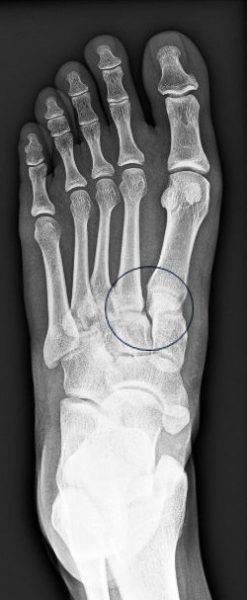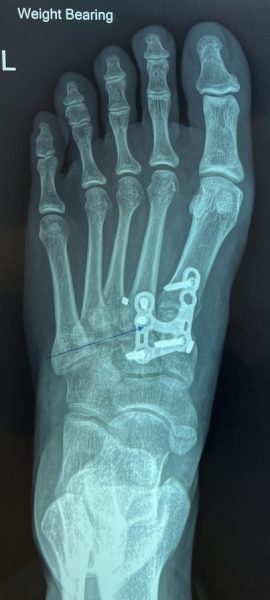A Lisfranc fracture-dislocation refers to an injury involving the bones and joints of the midfoot, specifically the tarsometatarsal joint complex. It is a severe injury that can result in significant functional impairment if not appropriately managed. Here are some key implications and treatment principles for Lisfranc fracture-dislocations:
Implications:
1. Ligamentous disruption: Lisfranc injuries typically involve disruption of the ligaments that support the tarsometatarsal joints. This can result in instability and misalignment of the midfoot, affecting weight-bearing and normal foot mechanics.

Lis Franc joint shows a subtle widening and misalignment suspicious for a Lis Franc ligamentous injury that was confirmed by an MRI scan

Lis Franc joint disruption corrected with plates and screws and a tightrope construct
2. Fractures: Fractures can occur in the bones of the midfoot, including the metatarsals and the cuneiforms. These fractures can vary in severity from hairline fractures to more complex and displaced fractures.
3. Soft tissue injury: In addition to ligament and bone injury, Lisfranc fracture-dislocations can cause damage to surrounding soft tissues, including muscles, tendons, and nerves.
Treatment principles:
- Early diagnosis and management: Prompt recognition and diagnosis of Lisfranc injuries are crucial to optimize outcomes. These injuries are often missed or misdiagnosed initially, leading to delayed treatment. Suspicion should be high, especially in cases of trauma involving the midfoot.
- Immobilization and non-weight bearing: Immobilization and non-weight bearing are typically initiated in the acute phase to protect the injured structures and allow for initial healing. This may involve the use of a cast, splint, or walking boot.
- Closed reduction and fixation: In cases where there is significant displacement or instability, closed reduction (realigning the bones without surgery) may be attempted. However, surgical intervention is often necessary to achieve and maintain proper alignment. Fixation methods can include screws, plates, or a combination of both.
- Rehabilitation and weight-bearing progression: Once the fracture-dislocation is appropriately stabilized, a rehabilitation program is initiated. This includes exercises to restore range of motion, strength, and balance. Weight-bearing is gradually progressed as the healing process allows.
- Individualized approach: The treatment of Lisfranc fracture-dislocations should be tailored to the specific injury pattern, patient factors (such as age and activity level), and surgeon expertise. Complex or severe cases may require a multidisciplinary approach involving orthopedic surgeons, podiatrists, and physical therapists.
If you or someone you know has suffered such an injury, it is crucial to consult with a qualified orthopedic specialist for an accurate diagnosis and appropriate treatment plan.





